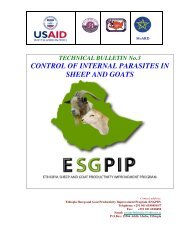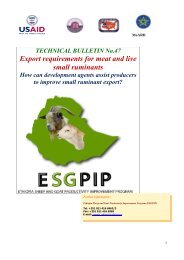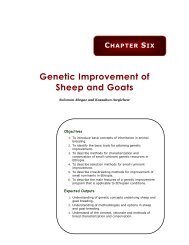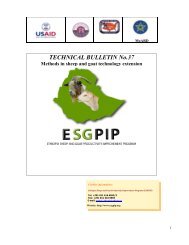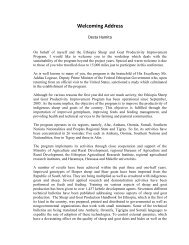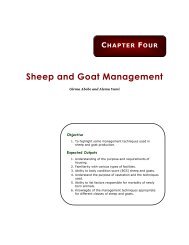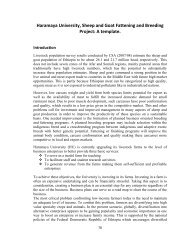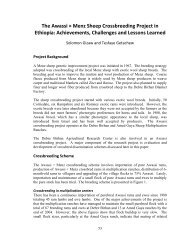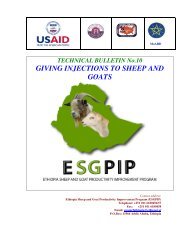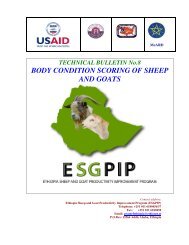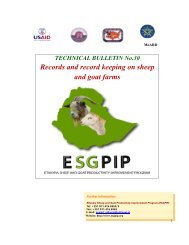Technical Bulletin No.23 - esgpip
Technical Bulletin No.23 - esgpip
Technical Bulletin No.23 - esgpip
You also want an ePaper? Increase the reach of your titles
YUMPU automatically turns print PDFs into web optimized ePapers that Google loves.
MoARD<br />
TECHNICAL BULLETIN <strong>No.23</strong><br />
Estimation of weight and age of sheep<br />
and goats<br />
Further information:<br />
Ethiopia Sheep and Goat Productivity Improvement Program (ESGPIP)<br />
Tel. +251 011 416 6962/3<br />
Fax: +251 011 416 6965<br />
E-mail: pvamrf_ethiopia@ethionet.et<br />
Website: http://www.<strong>esgpip</strong>.org
FOREWORD<br />
This technical bulletin titled “Estimation of weight and age of sheep and goats” is the 23rd in a<br />
series produced by the Ethiopia Sheep and Goat Productivity Improvement Program (ESGPIP).<br />
The ESGPIP is a USAID funded Project with the objective of improving the productivity of<br />
sheep and goats in Ethiopia.<br />
Knowing the weight and age of sheep and goats is very useful information to make appropriate<br />
management decisions. However, because of lack of accurate scales in most farms, linear<br />
dimensions of animals can be used to estimate weight. Equations correlating weight and linear<br />
measurements have been developed for some breeds. Animal age can be estimated by looking at<br />
the size, number and wear of teeth since small holder sheep and goat producers in Ethiopia rarely<br />
keep birth records. These being the major focus of this technical bulletin, other useful linear<br />
measurements are also included.<br />
The information contained in this bulletin is useful for development agents to train<br />
farmers/pastoralists and also for other users engaged in business ventures based on sheep and<br />
goat rearing.<br />
Desta Hamito (Prof.),<br />
Chief of Party,<br />
ESGPIP<br />
May, 2009<br />
i
TABLE OF CONTENTS<br />
FOREWORD ................................................................................................................................... i<br />
1. Introduction ........................................................................................................................... 1<br />
2. Needs of measuring dimensions ........................................................................................... 1<br />
3. Parts of the body of sheep and goats .................................................................................... 1<br />
4. Procedures for measuring weight ........................................................................................ 2<br />
5. Procedures for measuring linear dimensions ..................................................................... 3<br />
6. Estimating weight from linear measurements .................................................................... 6<br />
7. Importance of age determination ......................................................................................... 8<br />
8. Determining the age of sheep and goats through dentition ............................................... 8<br />
9. Summary .............................................................................................................................. 10<br />
10. References ............................................................................................................................ 10<br />
Appendix 1. ................................................................................................................................... 11<br />
ii
Estimation of weight and age of sheep and goats<br />
By: Solomon Abegaz and Kassahun Awgichew<br />
Editors: Alemu Yami, T.A. Gipson and R.C. Merkel<br />
1. Introduction<br />
The size and age of sheep and goats are normally related to their productivity. Larger sized<br />
animals usually produce more meat than smaller animals. Size is commonly represented by<br />
weight, though other linear measurements can be used. The size of an animal should be<br />
considered in relation to its age allowing for evaluation of growth performance used as a<br />
component in deciding which animals to buy, sell, cull or mate. Properly calibrated livestock scales<br />
are the most accurate and consistent method for determining body weight. Under farm conditions<br />
where scales and records may be absent, it may be difficult to know the weight and age of sheep<br />
and goats. Linear measurements of animals, in addition to providing body size, can be used to<br />
estimate weight. Change in dentition of sheep and goats from birth to maturity can be used to<br />
estimate age.<br />
2. Need of measuring dimensions<br />
The weight of a sheep or goat fluctuates as a result of management system, pregnancy, gut fill,<br />
lactation, etc.. Physical body characteristics or linear measurements are less affected by the<br />
above factors and allow for growth comparisons of different body parts at any stage or phase of<br />
growth. Measurements of various body conformations are of value in judging quantitative<br />
characteristics of meat and are also helpful in developing suitable selection criteria. Moreover,<br />
because of the relative ease in measuring linear dimensions they can be used as an indirect way<br />
to estimate weight.<br />
3. Parts of the body of sheep and goats<br />
It is important to know the different parts of the sheep and goat body to understand the different<br />
linear measurements described in this technical bulletins. Figure 1 presents the major parts of the<br />
body of a goat relevant to the parts referred to in this bulletin.<br />
1
Figure 1. Body parts of a goat<br />
4. Procedures for measuring weight<br />
Sheep and goats are weighed for many different purposes in addition to recording growth. In<br />
countries where the sale price is based on weight, live weight has a direct relation to the<br />
profitability of the enterprise. Knowledge of animal weight is also essential for determining the<br />
dosage level of some drugs and the amount of feed to be given to the animal. Animal weight is<br />
highly prone to within individual variation due to the amount of feed and water in the gut. To<br />
minimize variation:<br />
• Weigh at a constant time of day to obtain<br />
1. Fasted weight – best done in the morning before grazing or watering or<br />
2. Full gut weight – in the afternoon after animals have had time to eat as much as<br />
they want.<br />
Early morning weighing is commonly practiced when animals have been locked in barns or pens<br />
overnight. This system would obviously suit Ethiopian conditions as all sheep and goats are<br />
generally housed or kraaled at night. To minimize the variation when full gut weight is taken,<br />
weigh at the same time of day each time and ensure consistent feeding and watering prior to each<br />
weighing. Additional precautions needed in weighing animals include:<br />
• Checking the accuracy of scales against a known standard<br />
• Avoiding human errors such as mistaken ear tag numbers or other animal<br />
identifications, mistaken weight readings, etc.<br />
2
In consecutive weighings, the current weight should be compared with previous weights to note<br />
trends in live weight and guard against mistakes.<br />
Weighing lambs and kids at birth<br />
Birth weight is an important trait and is related to survival and growth performance. There are<br />
three main aspects to consider when measuring birth weight; Restraint, accuracy and reliability.<br />
Restraints: Without appropriate restraint of the animals, the scale reading fluctuates wildly. This<br />
causes serious error when detecting small differences in weight. Lambs and kids can be<br />
restrained by:<br />
i. a plastic bucket of known weight<br />
ii. placing the animal in a sack<br />
iii. suspended by the legs<br />
iv. suspended in simple harness<br />
Accuracy: Lamb birth weights commonly range from 1.5-4.0 kg and kid weights from 1.0-3.5<br />
kg, so it is important to use a scale which has sufficient accuracy. Scales reading to 0.1 kg should<br />
be the minimum accepted.<br />
Reliability: Clean and check the scales since the difference in birth weight to be detected is quite<br />
small. It is important to thoroughly maintain the balances/scales used.<br />
5. Procedures for measuring linear dimensions<br />
There are a number of linear dimensions which can be used to quantify the size of an animal and<br />
to estimate weight. Bear in mind that animal movement and body posture can introduce errors<br />
into measurements and estimated weights. Do the following to counteract these effects:<br />
i. When possible, choose measurements that are little affected by the animal’s posture<br />
ii. Standardize the position of all animals that are to be compared<br />
iii. Be patient and wait for an animal to stand correctly.<br />
The most widely used linear measurements include height at withers, heart girth, chest depth,<br />
body length, fore cannon bone and rump height. Heart girth and cannon bone length are least<br />
affected by the posture of the animal.<br />
Height at withers (HAW): - This measures the<br />
distance from the surface of a platform on which<br />
the animal stands to the withers. The measurement<br />
is best made with a special measuring stick made<br />
with two arms one which is held vertical and the<br />
other at right angles to it sliding firmly up and<br />
down to record height.<br />
Figure 2Measurement of height at withers<br />
3
The sheep or goat should stand squarely on all 4 legs. The legs should be equally spaced, and<br />
carry equal portions of its weight. Place the vertical arm of the measuring device on the ground<br />
and ensure it is at a right angle to the platform. Then slide the other shorter arm down until it just<br />
touches the shoulder at the desired point. Withdraw the vertical measuring device and measure<br />
distance with a measuring tape. Alternatively, the vertical arm could have the measuring scale<br />
inscribed onto it and height read directly (Figure 3).<br />
Figure 3. A labeled bar being used to measure height at withers; note the graduation on the bar<br />
Heart Girth (HG) or Chest circumference: Heart girth is<br />
a circumferential measure taken around the chest just<br />
behind the front legs and withers. The measurement should<br />
be taken to the nearest 0.5 cm. HG is a highly repeatable<br />
measure though it does vary somewhat with extremes of<br />
posture and perhaps as the animal breaths. It is the basis of<br />
the many weight tapes that are available for estimating<br />
animal weight as there is a good correlation between chest<br />
circumference and body weight, within breeds, sexes, and<br />
ages of stock. More reliable HG-live body weight Figure 4. Heart girth measurement<br />
relationships are obtained from mature animals. In<br />
excessively hairy sheep like the Menz sheep, make sure to compress the hair while measuring<br />
HG.<br />
Body length (BDL):- Body length refers to the distance from the base of the ear to the base of<br />
the tail (where it joins the body). It can also be measured as the distance from base of tail to the<br />
base of the neck (first thoracic vertebrae), or to front of the chest or to tip of the nose. Extreme<br />
care is needed to ensure that the backbone is straight in both vertical and horizontal planes.<br />
4
Figure 5. Body length measurement from tail base to three different points<br />
(occiptal protuberance, first cervical vertebrae or tip of nose)<br />
Hip width (pin bone width) (HW): Hip width is the distance between<br />
the outer edges of the major hip bones on the right and left side. The<br />
hipbones are easily located and the distance between them easily<br />
measured with a pair of large, half round or oval shaped calipers.<br />
Figure 6. Measurement of hip<br />
width<br />
Rump height (RH):- Rump height is the distance from the surface of a platform to the rump<br />
using a measuring stick as described for height at withers..<br />
Figure 7. Measurement of rump height<br />
Fore cannon bone length (CB): This is the length of the<br />
lower part of the leg extending from the hock to the fetlock<br />
in hoofed mammals. It is a well-established fact that linear<br />
development of different bones in the body is strongly<br />
related. The different parts grow in proportion to one<br />
another. It should be possible to estimate the length of a<br />
bone which is difficult to measure indirectly through its<br />
correlation with a more accessible one. The fore cannon<br />
bone is the one most commonly used.<br />
To measure fore cannon length, have the sheep or goat either stand or be held sitting on its rump.<br />
Take the front leg and bend back the hoof at the pastern and the leg itself at the knee. Use a<br />
suitable pair of large calipers, or a ruler or a measuring tape to measure the length of the main<br />
lower leg bone. For greatest accuracy, standardize your measurements using the same bony<br />
protuberances in each animal.<br />
5
Measurement of fore cannon bone Fore cannon bone<br />
Figure 8. Measurement of fore cannon bone<br />
Chest Depth (CD): Chest depth measures the distance from the backbone at the shoulder<br />
(standardize on one of the vertical processes of the thoracic vertebrae) to the brisket between the<br />
front legs as shown in figure 9.<br />
Figure 9. Measurement of Chest depth<br />
6. Estimating weight from linear measurements<br />
Increasing the genetic potential for meat production of a sheep or goat breed requires selection<br />
for increased size and live-weight. Proper size and weight measurements are often difficult in<br />
villages due to lack of weighing scales. Linear measures like heart girth are useful under these<br />
situations. Mathematical equations can be developed based on large number of actual weightlinear<br />
measurement data. The equations can be used to change linear measurements into weight<br />
estimates, usually via a constructed table (e.g. Appendix 1). Individual equations can be derived<br />
based on condition, sex and age of the animal. More than one linear measurement may be used in<br />
an equation to improve predictive ability. Examples of equations for Bonga, Horro, Afar and<br />
Menz sheep are shown in Table 1.<br />
6
Table 1. Equations to estimate weight using linear measurements for different sexes and age<br />
groups of sheep.*<br />
Breed Sex age Equations** R 2<br />
Horro Female One PPI*** -46.26+0.93HG 0.50<br />
Horro Female One PPI 28.15+0.62HG+0.61TC 0.61<br />
Horro Female Two PPI -21.20+0.65HG 0.49<br />
Horro Female All age group -36.13+0.86HG 0.54<br />
Horro Male All age group -39.96+1.03BL 0.81<br />
Bonga Female One PPI -17.24+0.65HG 0.45<br />
Bonga male One PPI -30.92+0.85HG 0.69<br />
Bonga male One PPI -40.53+0.69HG+0.31HAW 0.74<br />
Bonga Female All age group (1-4PPI) -33.34+0.90HG 0.62<br />
Bonga male All age group -40.95+0.99HG 0.77<br />
Menz Male All age group (0 and above PPI) -23.42+0.67HG 0.83<br />
Menz Female All age group (0 and above PPI) -23.29+0.67HG 0.80<br />
Afar Male All age group (0 and above PPI) -30.77+0.82HG 0.87<br />
Afar Female All age group (0 and above PPI) -31+0.80HG 0.78<br />
**HG=Heart girth HAW= Height at withers BL=Body length TC=Tail circumference<br />
*** PPI = Pair(s) of Permanent Incisors<br />
* Source: Tesfaye Getachew. 2008. MSc Thesis, Haramaya University<br />
Zewdu Edea. 2008. MSc Thesis, Haramaya Univrsity<br />
Example. If we want to estimate the weight of female Bonga, Horro, Menz and Afar sheep<br />
with a heart girth measurement of 70 cm we can use the following equations:<br />
Bonga: -33.34+0.90HG, Horro:-36.13+0.86HG, Menz:-23.29+0.67HG and –Afar: 31+0.80HG.<br />
Table 2. Estimation of the weight of female sheep using the respective equations for the<br />
breedof<br />
Breed Equation Estimated weight (Kg)<br />
Bonga female -33.34+0.9(70) 29.66<br />
Sheep<br />
Horro sheep -36.13+0.86(70) 24.07<br />
Menz sheep -23.29+0.67(70) 23.61<br />
Afar sheep -31.0+0.80(70) 25.00<br />
A table such as the one in the Annex can be prepared and used to read the estimated weights<br />
instead of resorting to calculations for each measurement. After each measurement the tables can<br />
be read for that particular size. Another option is to prepare a weight linear measurement tape<br />
where a weight for a corresponding linear measurement can be read from the tape itself (Figure<br />
9).<br />
7
Figure 10. Weight tape<br />
7. Importance of age determination<br />
In addition to weight and linear dimensions knowing the age of sheep and goats is important for<br />
a number of reasons. Some of the reasons are to:<br />
• decide when to cull<br />
• know and choose a sheep or goat to purchase<br />
• decide when to mate<br />
• know contemporaries for selection among them<br />
• adjust for age differences<br />
• have a good estimate of (reproductive) performance of a sheep or goat<br />
8. Determining the age of sheep and goats through dentition<br />
Since most smallholder farmers do not keep records, it is difficult to obtain information on age of<br />
animals. Under such circumstances age is estimated based on dentition. Normal tooth arrangement<br />
in animals is, from front to back is incisors, canines, premolars, and molars. Sheep and goats, like<br />
all ruminant animals, have no canine teeth and do not have upper jaw incisors, rather they have a<br />
thick layer of tissue called the “dental pad.”<br />
Lambs and kids start off with a set of temporary or commonly known as milk teeth. The<br />
temporary teeth are similar to the permanent teeth in form and placement but smaller in size and<br />
fewer in number. The numbers of temporary teeth are eight incisors at the front of the lower jaw<br />
and twelve molars and premolars at the back of both the upper and lower jaws.<br />
Mature sheep and goats have a total of 8 incisors (4 pair-lower jaw), 12 premolars (lower and<br />
upper jaw, 3 pairs each), and 12 molars (lower and upper jaw, 3 pairs each) making a total of 32<br />
teeth. When ageing sheep and goats by looking at their teeth, one considers “pairs” of incisors<br />
rather than their total. The four pairs which exist at birth or erupt after birth will be replaced by<br />
permanent incisors as the animal ages. The replacement of the incisor pairs takes place roughly<br />
every 12 months beginning with the center pair. This pattern of replacement can be used to estimate<br />
age of sheep and goats.<br />
After the final pair of incisors has been replaced, the wear of the permanent teeth can give an<br />
indication of age.<br />
8
Table 2. Estimated age for sheep and goats with different numbers of erupted permanent incisors<br />
No. of permanent incisors Estimated age range<br />
Sheep<br />
Goat<br />
0 pair Less than 1 year Under 1 year<br />
1 pair 1-1½ years 1-2 years<br />
2 pairs 1½-2years 2-3 years<br />
3 pairs 2½-3years 3-4 years<br />
4 pairs More than three years. More than four years<br />
Broken mouth Aged Aged<br />
Milk teeth . 2 permanent (central) teeth<br />
4 permanent teeth 6 permanent teeth<br />
Full mouth – 8 permanent teeth<br />
Broken mouth<br />
Figure 11. Dentition showing the estimated ages of sheep and goats (Adopted from Vatta et al.<br />
2006)<br />
9
9. Summary<br />
Sheep and goat producers would like to know the size and age of their animals for various<br />
purposes. Size is commonly measured using live weight. However, because of lack of accurate<br />
scales linear dimensions of animals can be used to estimate weight. Equations correlating weight<br />
and linear measurements have been developed for some breeds. Small holder sheep and goat<br />
producers rarely keep birth records and animal age can be estimated by looking at the size,<br />
number and wear of teeth.<br />
What can Kebele Development Agents (KDAs) do<br />
• Teach and advise farmers about the importance of weight measurement and how to<br />
measure weight accurately.<br />
• Teach and advise farmers about the importance of linear measurements, which<br />
measurements are most useful and how to accurately measure the linear<br />
dimensions.<br />
• train farmers on the importance of age determination in the management of sheep<br />
and goats and how to use dentition to estimate age<br />
10. References<br />
Solomon Gizaw. 1995. Estimation of bodyweight from linear body measurements and the<br />
influence of body condition and age on the accuracy of body weight estimation in<br />
Ethiopian Horro sheep. Small Ruminant Network Newsletter. 31:5-9<br />
Tesfaye Getachew. 2008. Characterization of Menz and Afar indigenous sheep breeds of<br />
smallholders for designing community-based breeding strategies in Ethiopia. M.Sc.<br />
Thesis. Haramya University. 134.pp.<br />
Thwaites, C.J. 1994. A manual for sheep research. Memeographed.<br />
Vatta, A.F., Abbot, M.A., Villiers, J.F., Gumede, S.A., Harrison, L.J.S., Krecek, R.C.,<br />
Letty, B.A., Mapeyi, N. and Pearson, R.A. 2006. Goat Keepers’ Animal Health Care<br />
Manual. Agricultural Research Council. Onderstepoort Veterinary Institute with<br />
KwaZulu-Natal Department of Agriculture and Environment, South Africa, 60 pp<br />
Zewdu Edea. 2008. Characterization of Bonga and Horro indigenous sheep breeds of<br />
smallholders for designing community-based breeding strategies in Ethiopia. M.Sc.<br />
Thesis. Haramya University. 124.pp<br />
10
Appendix 1.<br />
Relationship of Heart girth measurement with body weight of Horro sheep*<br />
Heart girth<br />
Weight of one- year old<br />
sheep (kg)<br />
Weight of two- year-old<br />
sheep (kg)<br />
Weight of 3-5 year old<br />
sheep (kg)<br />
measurement(cm) Poor<br />
condition<br />
Good<br />
condition<br />
Poor<br />
condition<br />
Good<br />
condition<br />
Poor body<br />
condition<br />
Good **<br />
condition<br />
60 14.30<br />
62 15.46<br />
64 16.62<br />
66 17.78 18.25<br />
68 18.94 19.63 18.62 19.67<br />
70 20.10 21.01 19.86 21.45 20.88 20.98<br />
72 21.26 22.39 21.10 23.23 22.06 22.86<br />
74 22.42 23.77 22.34 25.01 23.24 24.74<br />
76 23.58 25.15 23.58 26.79 24.42 26.62<br />
78 24.74 26.53 24.82 28.57 25.60 28.50<br />
80 25.90 27.91 26.06 30.35 26.78 30.38<br />
82 27.06 29.29 27.30 32.13 27.96 32.26<br />
84 28.22 30.67 28.54 33.91 29.14 34.14<br />
86 29.38 32.05 29.78 35.69 30.32 36.02<br />
88 30.54 33.43 31.02 37.47 31.50 37.90<br />
90 31.70 34.81 32.26 39.25 32.68 39.78<br />
92 32.86 36.19 33.50 41.03 33.86 41.66<br />
94 34.02 37.57 34.74 42.81 35.04 43.54<br />
96 35.18 38.85 35.98 44.59 36.22 45.42<br />
98 36.34 39.23 37.22 46.37 37.40 47.30<br />
100 37.50 40.61 38.46 48.15 38.58 49.18<br />
* Adopted from Solomon Gizaw. 1995<br />
** Refer to ESGPIP technical <strong>Bulletin</strong> number 8 on body condition scoring.<br />
11



